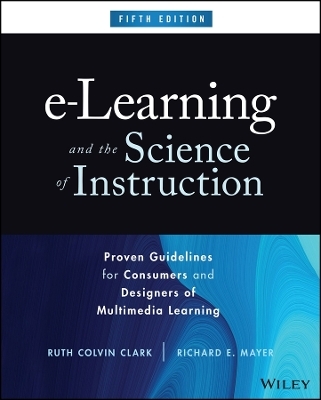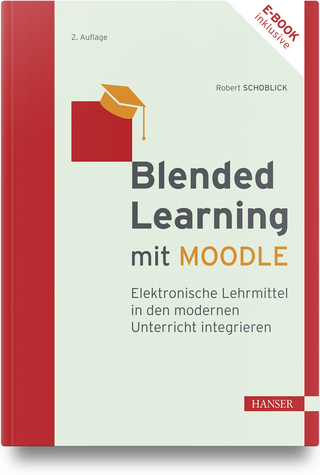
e-Learning and the Science of Instruction
John Wiley & Sons Inc (Verlag)
978-1-394-17737-0 (ISBN)
e-Learning and the Science of Instruction, 5th Edition: Proven Guidelines for Consumers and Designers of Multimedia Learning helps practitioners apply evidence-based principles to the design, development, and selection of digital instructional and training materials. This book goes beyond instructional design advice, providing actionable ideas and multimedia examples based on recent research findings. You will learn how to put evidence into practice, with proven e-learning design and development guidelines.
During the pandemic, e-learning assumed a much greater role as an instructional delivery medium, especially with virtual classrooms using tools such as Zoom and MS Teams. The combination of new technological functionality, increases in a remote workforce, and new research findings have led to gaps regarding how to leverage digital learning most effectively. This book explains what instructional designers, multimedia developers, and e-learning consumers need to know to maximize the potential of their e-learning resources. In addition to guidelines regarding use of graphics, audio, text, engagement techniques and collaborative online learning, this new edition covers video-based instruction, digital games, and immersive virtual reality-, showing you when and how to utilize these tools effectively.
Discover the latest research findings about how people learn—and how they learn best online
Build instructional materials, including video instruction, digital games, and immersive VR experiences, that empower learners to succeed
Get ideas and inspiration for engaging learners in synchronous and asynchronous environments
See concrete examples of how research evidence in instructional design can be applied in practice
Apply evidence regarding how best to leverage collaborative online learning
e-Learning and the Science of Instruction is a valuable resource for students and practitioners who need to design, develop, and select effective eLearning and virtual training materials.
Richard E. Mayer, Ph.D., is a Distinguished Professor of Psychological and Brain Sciences at the University of California, Santa Barbara. His research focuses on the intersection of cognition, instruction, and technology. He is the author of more than 600 publications, including 40 books, and has been recognized as the most productive educational psychologist in the world. Ruth Colvin Clark, Ed.D., is the President and Principal Consultant of Clark Training & Consulting. She is a specialist in evidence-based training methods and bridging the gap between academic research and practitioner application.
Preface xv
Part I Foundations of e-Learning and the Science of Instruction 1
1 e-Learning: Promise and Pitfalls 3
What Is e-Learning? 4
The Evolution of e-Learning for Training 7
Is e-Learning Better? 9
The Promise of e-Learning 10
The Pitfalls of e-Learning 13
e-Learning Architectures 14
Twenty Years Later 15
2 How People Learn from e-Courses 19
How Do People Learn? 21
Guiding the Learner’s Cognitive Processing During Learning 25
Core Goals for Instructional Design in e-Learning 27
How e-Lessons Affect Learning 31
Summary of Learning Processes 34
What We Don’t Know About Learning 35
3 Evidence-Based Practice 39
What Is Evidence-Based Practice? 40
Rationale for Evidence-Based Practice 41
Three Approaches to Research on Instructional Effectiveness 42
What to Look for in Experimental Comparisons 43
What Are Boundary Conditions? 49
What Is a Meta-Analysis? 49
Limits of Experimental Research 50
Where Can You Find Relevant Research? 50
The Evolution of Evidence-Based Practice 51
What We Don’t Know About Evidence-Based Practice 51
Part II How to Leverage Visuals and Words in e-Learning 55
4 Applying the Multimedia Principle: Use Words and Graphics Rather than Words Alone 57
Do Visuals Make a Difference? 59
Multimedia Principle: Include Both Words and Graphics 60
Some Ways to Use Graphics to Promote Learning 63
Psychological Reasons for the Multimedia Principle 66
Evidence for Using Words and Pictures 67
When to Use Animations 72
How to Optimize Learning from Graphics 73
What We Don’t Know About Visuals 74
5 Applying the Contiguity Principle: Align Words to Corresponding Graphics 81
Spatial Contiguity Principle: Place Printed Words near Corresponding Graphics 83
Violations of Spatial Contiguity 85
Psychological Reasons for the Spatial Contiguity Principle 90
Evidence for the Spatial Contiguity Principle 90
Temporal Contiguity Principle: Synchronize Spoken Words with Corresponding Graphics 94
Psychological Reasons for the Temporal Contiguity Principle 96
Evidence for the Temporal Contiguity Principle 97
What We Don’t Know About Contiguity 98
6 Applying the Signaling Principle: Use Verbal and Visual Cues to Direct Attention 103
What Is Signaling? 104
How Does Signaling Work? 105
Evidence for the Benefits of Signaling 106
Signaling: The Bottom Line 110
What We Don’t Know About Signaling 110
7 Applying the Modality Principle: Present Words as Audio Narration Rather Than On-Screen Text 115
Modality Principle: Present Words as Speech Rather Than On-Screen Text 117
Psychological Reasons for the Modality Principle 119
Evidence for Using Spoken Rather Than Printed Text 121
When Audio Is Not Effective: Boundary Conditions for the Modality Principle 123
What We Don’t Know About Modality 127
8 When to Add Text to Audio Narration: Applying the Redundancy Principle 131
What Is the Redundancy Principle? 133
Psychological Reasons for the Redundancy Principle 133
Evidence for Omitting Redundant On-Screen Text 137
Add On-Screen Text to Narration in Special Situations 138
The Bottom Line 142
What We Don’t Know About Redundancy 142
9 Applying the Coherence Principle: Adding Extra Material Can Hurt Learning 149
Principle 1: Avoid e-Lessons with Extraneous Words 152
Principle 2: Avoid e-Lessons with Extraneous Graphics 156
Principle 3: Avoid e-Lessons with Extraneous Audio 165
What We Don’t Know About Coherence 166
Part III How to Promote Skill Building in e-Learning 171
10 Engagement in e-Learning: Activities for Promoting Generative Learning 173
What Is Engagement? 175
Engagement and Generative Processing 176
Behavioral Versus Psychological Engagement 177
When Behavioral Engagement Impedes Learning 178
Three Engagement Activities That Can Promote Generative Processing 180
The Bottom Line to Engagement in e-Learning 185
What We Don’t Know About Generative Learning 186
11 Leveraging Examples in e-Learning 191
What Is Example-Based Instruction? 192
The Psychology of Example-Based Instruction 195
Evidence for the Benefits of Example-Based Instruction 196
How to Optimize the Benefits of Example-Based Instruction 197
What We Don’t Know About Worked Examples 208
12 Does Practice Make Perfect? 213
What Is Practice in e-Learning? 215
Is Practice a Good Investment? 217
Principle 1: Add Sufficient Practice Interactions to Achieve the Objective 219
Principle 2: Make Sure Practice Mirrors the Job 221
Principle 3: Provide Effective Feedback on Practice Performance 221
Principle 4: Distribute and Mix Practice Among Learning Events 227
Principle 5: Arrange Practice That Increases in Challenge as Learners Progress 229
Principle 6: Provide Scaffolding to Support Guided Practice When Needed 229
Principle 7: Apply Multimedia Principles in Designing Feedback 231
What We Don’t Know About Practice 232
Part IV How to Organize Content in e-Learning 235
13 Organizing Instruction: Applying the Segmenting and Pretraining Principles 237
What Is the Segmenting Principle? 239
What Is the Pretraining Principle? 244
Psychological Reasons for the Pretraining Principle 248
Managing Essential Overload 249
What We Don’t Know About Segmenting and Pretraining 250
14 Who’s in Control?: Guidelines for e-Learning Navigation 255
Learner Control Versus Program Control 257
Do Learners Make Good Instructional Decisions? 260
The Psychology of Learner Decisions 263
Four Principles for Learner Control in e-Learning 264
The Bottom Line 271
What We Don’t Know About Learner Control 271
Part V How to Leverage Social Cues in e-Learning 275
15 Applying the Personalization Principle: Use Conversational Style, Polite Wording, Friendly Voice, On-Screen Agents, and Social Presence in e-Learning 277
Personalization Principle 1: Use Conversational Rather Than Formal Style 280
Personalization Principle 2: Use Polite Wording 285
Personalization Principle 3: Use a Friendly Human Voice Quality for Narrations 286
Can On-Screen Agents Promote Learning in Asynchronous e-Learning? 287
How Can Instructors in Video Lessons Leverage Personalization? 293
What We Don’t Know About Personalization 295
16 Online Collaborative Learning 299
What Is Collaborative Learning? 301
The Psychology of Collaborative Learning 303
What Is Computer-Supported Collaborative Learning (CSCL)? 304
Principle 1: Design Tasks and Team Assignments to Foster Interdependence 307
Principle 2: Optimize Group Size, Prior Knowledge, and Collaboration Experience 309
Principle 3: Consider Tradeoffs Between Synchronous and Asynchronous Collaboration 310
Principle 4: Maximize Social Presence in Online Collaborative Environments 312
Principle 5: Use Scripts to Optimize Team Outcomes 313
What We Don’t Know About Online Collaborative Learning 316
Part VI Special Applications of e-Learning 319
17 e-Learning to Build Thinking Skills 321
What Are Thinking Skills? 323
What to Teach: Focused Target Skills Versus Improving the Mind in General 325
Where to Teach: Domain-General Versus Domain-Specific Thinking Skills 325
How to Teach: Expert Modeling with Learner Practice Versus Direct Instruction 326
Can Thinking Skills Be Trained? 326
Principle 1: Build Explicit Instruction to Teach Specific Job-Relevant Thinking Skills 328
Principle 2: Incorporate Online Simulations of Authentic Work Scenarios 332
Principle 3: Identify Job-Specific Thinking Processes 335
Teaching Thinking Skills: The Bottom Line 336
What We Don’t Know About Teaching Thinking Skills 336
18 Designing Effective Instructional Video 341
The Challenge of Instructional Video 343
Historical Foundations of Instructional Video 343
Uses of Instructional Video 343
Principle 1: Record a Demonstration Video from a First-Person Perspective 345
Principle 2: Have the Instructor Draw on the Board While Lecturing 346
Principle 3: Embed Generative Activities During Breaks in the Video 347
Principle 4: Add Subtitles for Learning in a Second Language 348
Principle 5: Have the Instructor Exhibit Positive Voice and Gestures 349
Principle 6: Have the Instructor Use Pointing and Eye Gaze to Direct Attention 350
Principle 7: Avoid Overuse of Talking Heads or Static Instructor Images 351
Principle 8: Apply Multimedia Design Principles 352
What We Don’t Know About Instructional Video 353
19 Learning with Computer Games 357
Do Games Have a Place in the Serious Business of Training? 359
Which Features Improve a Game’s Effectiveness? 359
What Are the Cognitive Consequences of Playing Off-the-Shelf Computer Games? 365
Are Games More Effective Than Conventional Media? 368
What We Don’t Know About Learning with Computer Games 375
20 Immersive Virtual Reality for Instruction 379
The Promise and Pitfalls of Learning in Immersive Virtual Reality 381
What Is Immersive Virtual Reality? 382
Three Levels of Immersion 383
Is Immersive Virtual Reality Better for Learning Than Traditional Media? 383
When to Use Immersive Virtual Reality Learning Environments 386
How to Use Immersive Virtual Reality Training Environments 386
What We Don’t Know About Immersive Virtual Reality 389
21 Applying the Multimedia Guidelines 395
How Strong Is the Evidence for the Multimedia Principles? 395
e-Learning Guidelines Checklists 400
Trends in Multimedia Instructional Design Research 404
The Future of Multimedia Instructional Design Research 405
Conclusion 407
Glossary 409
References 429
Acknowledgments 459
About the Authors 461
Author Index 463
Subject Index 473
| Erscheinungsdatum | 05.12.2023 |
|---|---|
| Verlagsort | New York |
| Sprache | englisch |
| Maße | 185 x 234 mm |
| Gewicht | 907 g |
| Themenwelt | Schulbuch / Wörterbuch ► Unterrichtsvorbereitung ► Unterrichts-Handreichungen |
| Mathematik / Informatik ► Informatik ► Theorie / Studium | |
| Sozialwissenschaften ► Pädagogik | |
| Technik | |
| Wirtschaft ► Betriebswirtschaft / Management ► Personalwesen | |
| Wirtschaft ► Betriebswirtschaft / Management ► Planung / Organisation | |
| ISBN-10 | 1-394-17737-2 / 1394177372 |
| ISBN-13 | 978-1-394-17737-0 / 9781394177370 |
| Zustand | Neuware |
| Haben Sie eine Frage zum Produkt? |
aus dem Bereich


